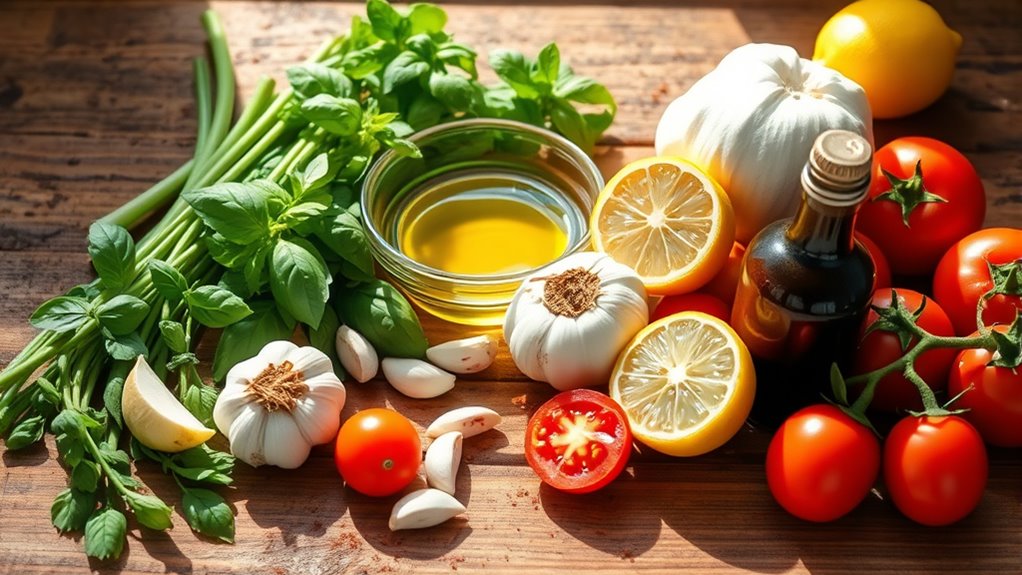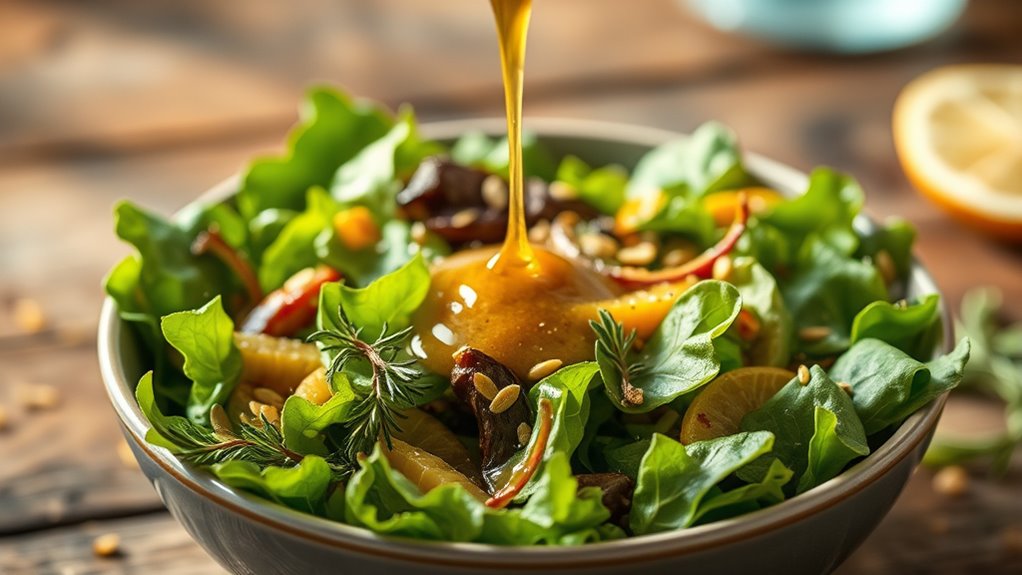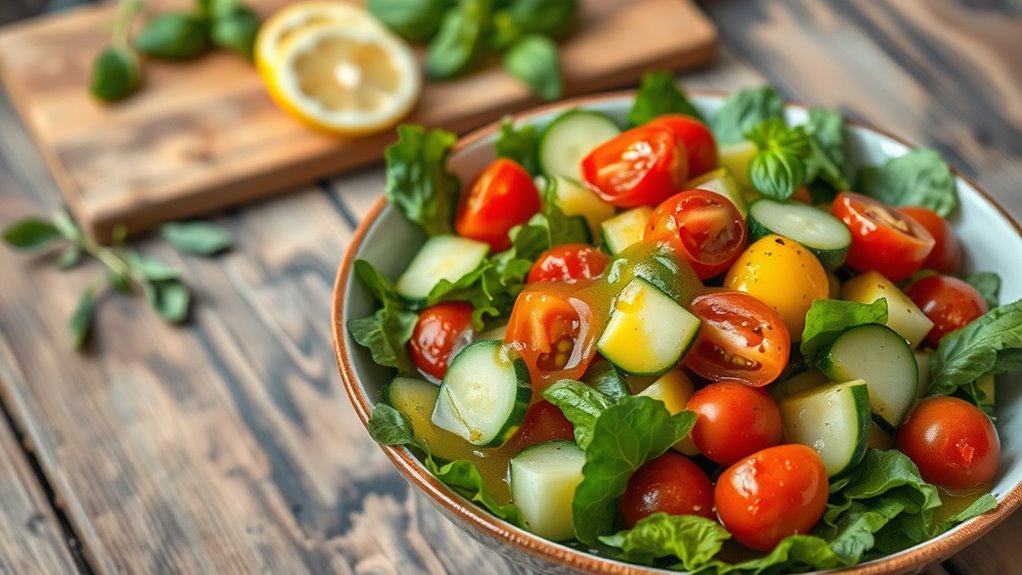This BUCA-style dressing coats greens with a glossy, emulsified veil of olive oil, white wine vinegar, and Dijon, brightened by garlic powder, onion powder, and oregano. You whisk until the emulsion shimmers and clings like satin, then season to taste for that perfect tang-sweet balance. Keep the tempo steady as you adjust acidity, add a whisper of sugar, and aim for a smooth, cool surface. If you keep exploring, you’ll uncover more tips and tweaks that elevate it further.
Ingredients and Quantity

The Buca-style dressing starts with a precise blend: 1/2 cup extra-virgin olive oil, 2 tablespoons white wine vinegar, 1 teaspoon Dijon mustard, 1/2 teaspoon garlic powder, 1/2 teaspoon onion powder, 1/4 teaspoon dried oregano, a pinch of sugar, and salt and pepper to taste.
You mix with intent, watching the emulsion thicken as aromas unfold—fruity olive oil, zing of vinegar, and a warm, herbaceous whisper from oregano. This is Buca salad authenticity in a bottle: a homemade dressing that invites tasting, adjusting, and savoring.
| Oil & Vinegar | Herbs & Seasoning | Finish & Texture |
|---|---|---|
| 1/2 cup EVOO | 1/4 tsp oregano | Smooth, glossy coat |
| 2 Tbsp vinegar | Garlic/ON powder | Balanced brightness |
| 1 tsp Dijon | Pinch sugar | Creamy cling |
| Salt & pepper | Long, clean finish | |
Preparations

To prepare the Buca-style dressing, whisk the oil, vinegar, Dijon, garlic powder, onion powder, oregano, and sugar in a bowl until the mixture gleams and edges toward a smooth emulsion; you should hear a faint whisper of emulsification as it thickens just enough to coat the back of a spoon. You’ll notice the oils curdle into a glossy, cohesive ribbon, then relax into a velvety suspension. Taste as you go, adjusting salt and acid to suit your pantry’s personality. In this stage, flavor enhancement happens through balance: fat carries notes, acidity shines, and aromatics wake. Use the dressing boldly across greens to inspire salad variations that feel both precise and liberating.
Kitchen tools or Kitchenware Required

A few essential tools will keep this dressing simple and precise: a medium whisk or a small to medium bowl whisk, a sturdy 1–2 cup measuring spout or cup, and a clear, nonreactive mixing vessel for emulsification. You’ll feel the texture bloom as ingredients meet rhythm, and you’ll taste the difference when the emulsion tightens with steady motion. For deeper resonance, consider the table below as a map of purpose, balance, and flow.
| Tool | Purpose | Sensory cue |
|---|---|---|
| salad mixers | blend smoothly | glossy, whispering satin |
| measuring cups | portion control | crisp edge, click of metal |
| vessel | emulsify | cool, glassy surface |
Precision meets freedom in your kitchen.
How to Cook

- Warm the mood of your dressing by whisking or emulsifying the components with steady, confident motions.
- Sense the oils loosen and cream into a glossy sheen.
- Balance tang and sweetness in the mixture.
- Add acid, salt, and aromatics until the texture sings.
- Keep the tempo steady; if the dressing thickens, add a thin veil of water or more oil to restore silkiness.
- Taste as you go, adjusting brightness with lemon or vinegar and a pinch of pepper.
- For healthy alternatives, substitute yogurt or tahini for richness without heaviness.
- Customize dressing variations by adding herbs, citrus zest, or capers.
How to Serve

When you’re ready to serve, drizzle the dressing over crisp greens or a grain bowl and watch the sheen cling to each leaf. You’ll notice a bright aroma that hints at citrus and garlic, then a mellow, savory finish that lifts every bite. For serving, aim for a thin, even coat that highlights texture rather than drowning it. Toss briefly to marry flavors without collapsing delicate greens. Present with a light, peppered crunch from toasted seeds or chopped herbs for contrast. Serving suggestions include pairing with quinoa, farro, or arugula to echo the dressing’s acidity. Presentation ideas emphasize a clean bowl, scattered citrus zest, and microgreens for color. Keep portions modest to preserve balance and elegance.
Tips
To get the most from this Buca salad dressing, start with a balanced base: whisk citrusy brightness with a touch of sweetness and a hint of savoriness, then adjust salt to taste. You’ll sharpen texture and aroma by letting it rest briefly, awakening oils and zest. Here are tips to dial it in without fluff, focusing on precision and freedom:
Start with a balanced citrusy base, then rest briefly to wake oils and zest.
- salad variations: experiment with greens that hold dressing, like romaine crunch or baby kale
- dressing alternatives: swap lemon for orange or vinegar for white wine to shift cut
- temperature control: serve slightly cool for lift or room temp for integration
- emulsification: whisk vigorously or shake in a jar to build a creamy coat
Enjoy, adjust, and savor the chef’s liberty.
Food Value and Benefit
Buca salad dressing is not only a burst of bright flavor but also a nutrient-rich addition that enhances the nutritional value of your meals. This dressing combines ingredients that provide essential vitamins, minerals, and health benefits, making it an excellent choice for a healthy diet.
Food Value:
- Rich in healthy fats from olive oil, providing essential fatty acids
- Contains antioxidants and lutein from fresh herbs
- Includes immune-supporting compounds from garlic and lemon juice
- Offers protein-enhancing elements when combined with yogurt or parmesan
Vitamins and Minerals:
- Vitamin A (from fresh herbs)
- Vitamin C (from lemon juice and garlic)
- Vitamin E (from olive oil)
- Calcium (from parmesan and yogurt)
- Potassium (from lemon juice)
- Antioxidants (from herbs and garlic)
Benefits of Eating This Recipe:
- Aids digestion and stimulates appetite due to its bright acidity
- Supports cell membrane health and provides steady energy from olive oil
- Enhances immune function with compounds found in garlic and lemon juice
- Provides antioxidants that help reduce oxidative stress
- Promotes satiety and longer-lasting fullness with protein-friendly additions
- Offers a versatile and healthful pairing that complements a variety of meals and supports consistent healthy eating habits
Frequently Asked Questions
Can I Make This Dressing Dairy-Free?
Dairy-free yes—you can swap in dairy-free alternatives and vegan options while keeping creaminess. Think cashew cream or coconut yogurt, lemon juice for brightness, and olive oil—your freedom to customize tastes like a sunlit kitchen symphony.
How Long Does It Stay Fresh in the Fridge?
You’ll get about 5–7 days in the fridge. Store upright, seal tightly, and sniff for freshness; if it smells sour or off, discard. Storage tips emphasize labeled dates; freshness indicators include bright color and emulsified texture.
Can I Substitute Lemon for Vinegar?
You can substitute lemon for vinegar, but flavor shifts matter: a bright, citrusy zing replaces sharpness. About 90% of readers prefer acid balance when using lemon alternatives and vinegar types in dressings. You’ll notice subtler, aromatic brightness.
Is There a Low-Calorie Version Available?
Yes, you can; try low-calorie swaps like light vinaigrettes and yogurt-based blends. You’ll notice tang, creaminess, and aroma, while discovering healthy alternatives that preserve texture. You’ll savor vibrant, zesty, freedom-filled flavors without guilt.
What Dishes Pair Best With This Dressing?
Unleash the flavor: you’ll love pairing this dressing with crisp greens, grilled chicken, and roasted vegetables. For salad pairings, experiment with bright citrus or herbaceous dressing variations to elevate every bite and celebrate culinary freedom.
